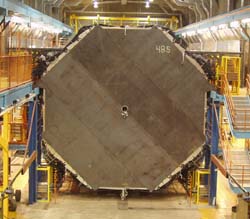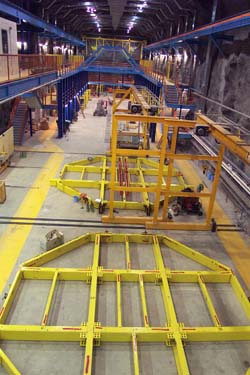 |
|
MINOS: Last Plane at Soudan by Kurt Riesselmann After four years of work in a former iron mine a half-mile underground, the Main Injector Neutrino Oscillation Search collaboration celebrated a milestone for the ambitious MINOS particle physics experiment. On June 5, technicians erected the last of 485 house-high detector planes of steel and plastic in the Soudan Underground Laboratory in Soudan, Minnesota. "The technicians carried out the work faster and less expensively than estimated," said Bill Miller, responsible for hiring and supervising the technicians at the lab. "We used six people less than the original labor estimate, and yet we ended up installing six planes per week, more than the original projection. We had a really excellent crew of workers. That was the key to our success." Overall, the four-year project finished on schedule and on budget. The faster-than-expected installation made up for time lost during the excavation of the cavern that hosts the experiment.
"It was like building a ship in a bottle," said MINOS spokesperson Stanley Wojcicki, physics professor at Stanford University. "We needed to bring all the material underground and assemble it right there. It was a real challenge to coordinate the logistics." The project began in July 1999, with the groundbreaking for the cavern that now hosts the detector. The installation of the first plane occurred in August of 2001. Because of limited storage space in the underground area, the work crew relied on continuous delivery of steel sections through the shaft. "Because the transportation cage was used during the day for tourists visiting the old iron mine, we lowered the pieces underground during the second shift at night," said Fermilab physicist Jeff Nelson, who explained that the Soudan mine is a State Park with 30,000 visitors per year. "We had a crew of three on the surface, working year-around. Over the two years, only three shifts were canceled due to weather." To carry out the two-year project, the Soudan laboratory hired about 30 technicians, many of whom it recruited from among the 1,300 people that were laid off when a steel company stopped mining in Soudan in 2001. Now, with the detector installation almost complete, workers are again forced to change jobs. "It was a rather anticlimactic end of the project. When the last plane went up we laid off 17 people," said Miller, who has worked at the underground lab for 17 years. Many of the laid-off technicians have been able to secure summer jobs, but with another mine shutting down and laying off 600 people the prospects are less than rosy. During the installation, technicians worked in two ten-hour shifts and accounted for about 75 percent of the total manpower. A mix of graduate students, postdocs and senior scientists from many of the 32 MINOS institutions from six countries—Brazil, France, Greece, Russia, United Kingdom and the United States—significantly contributed to the work at Soudan as well, with a special emphasis on the installation of the electronics and the commissioning of detector planes within days of their installation. Work on the detector, however, was not limited to the Soudan mine. A number of university and laboratory groups in the U.S., UK, and Greece worked at their home institutions on the production of detector components, representing more than half the cost of the detector. In a carefully coordinated effort, the groups built and tested the pieces of the plastic scintillator system and then shipped them to the Soudan mine for installation. In about a month, the whole detector will be ready to observe cosmic rays and atmospheric neutrinos, which easily penetrate the surface of the earth and reach the MINOS detector deep underground. For the last nine months, scientists have already used half of the detector to record particle interactions. In April, the MINOS collaboration reported its first scientific results, the identification of twelve atmospheric neutrino events.
MINOS will enter its next stage in 2005, when scientists will use the detector to “catch” neutrinos created 450 miles away at Fermilab in Batavia, Illinois. The beam line creating the neutrinos is under construction. When ready, about five trillion muon neutrinos per year will travel straight through rock and traverse the detector in Soudan, but only about 1,500 of the rarely-interacting particles are predicted to leave a trace inside the detector. Scientists will use the long-distance experiment to study the oscillation of muon neutrinos into electron neutrinos or tau neutrinos under laboratory conditions. "We really appreciate the work the technicians did for us," said Nelson, who has spent most of his last two years in Minnesota. "Now it has gone from beehive activity to taking care of the last details." He and his colleagues will make sure that physics data will keep the lab abuzz. ON THE WEB: MINOS homepage: www-numi.fnal.gov Photos of the MINOS far detector construction: www.sudan.umn.edu/Albums/MINOS/Weekly_Photos/ Soudan Underground Laboratory: www.sudan.umn.edu |
| last modified 7/7/2003 email Fermilab |
FRLsDFx9eyfrPXgV
 The whole detector is about 100 feet long and consists of massive planes that are lined up like the slices in a loaf of bread. Each plane consists of a sheet of steel, about 25 feet high and one inch thick, covered on one side with a half-inch layer of scintillating plastic. Because all material had to enter the cavern through
an old narrow shaft, the 6,000-ton detector arrived in pieces not more than seven feet in width.
The whole detector is about 100 feet long and consists of massive planes that are lined up like the slices in a loaf of bread. Each plane consists of a sheet of steel, about 25 feet high and one inch thick, covered on one side with a half-inch layer of scintillating plastic. Because all material had to enter the cavern through
an old narrow shaft, the 6,000-ton detector arrived in pieces not more than seven feet in width.
 Over the next two years MINOS scientists will
focus on the so-called CPT test of atmospheric
neutrino interactions, looking for differences in the
interactions of matter and antimatter. Unlike earlier
neutrino experiments such as Super-Kamiokande,
MACRO and Soudan 2, the MINOS detector
features a 1.5-Tesla magnet that allows scientists
to distinguish between signals caused by neutrinos
and antineutrinos.
Over the next two years MINOS scientists will
focus on the so-called CPT test of atmospheric
neutrino interactions, looking for differences in the
interactions of matter and antimatter. Unlike earlier
neutrino experiments such as Super-Kamiokande,
MACRO and Soudan 2, the MINOS detector
features a 1.5-Tesla magnet that allows scientists
to distinguish between signals caused by neutrinos
and antineutrinos.